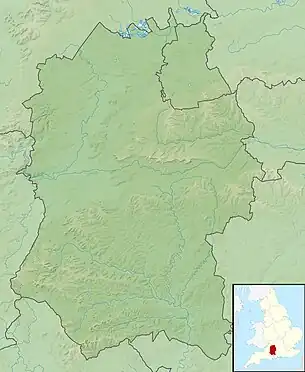Windmill Hill, Avebury
Windmill Hill is a Neolithic causewayed enclosure in the English county of Wiltshire, part of the Avebury World Heritage Site, about 1 mile (2 km) northwest of Avebury. Enclosing an area of 21 acres (8.5 ha), it is the largest known causewayed enclosure in Britain.[1] The site was first occupied around 3800 BC, although the only evidence is a series of pits apparently dug by an agrarian society using Hembury pottery.
| UNESCO World Heritage Site | |
|---|---|
 | |
| Location | Wiltshire, United Kingdom |
| Part of | Avebury Section of Stonehenge, Avebury and Associated Sites |
| Criteria | Cultural: (i), (ii), (iii) |
| Reference | 373bis-002 |
| Inscription | 1986 (10th Session) |
| Extensions | 2008 |
| Coordinates | 51°26′30″N 1°52′34″W |
 Location of Windmill Hill, Avebury in Wiltshire | |
During a later phase, c. 3700 BC,[2] three concentric segmented ditches were placed around the hilltop site, the outermost with a diameter of 365 metres. The causeways interrupting the ditches vary in width from a few centimetres to 7 m. Material from the ditches was piled up to create internal banks; the deepest ditches and largest banks are on the outer circuit. In the same period there was also a rectangular mortuary enclosure.[3]
The site was designated as a scheduled monument in 1925.[3] It came into the ownership of the National Trust in 1942[4] and is under the guardianship of English Heritage.[5]
Archaeological investigations
The site was bought by Alexander Keiller in 1924 and excavated over several seasons from 1925 to 1929 by Keiller and Harold St George Gray, whose work established it as the type site for causewayed camps, as they were then called. There were further excavations in 1957–1958.[4]
Pottery from the bottom of the ditches was the type style for the Windmill Hill culture. Later occupation layers contained early Peterborough ware, then the later Mortlake and Fengate varieties. Large quantities of bone, both human and animal, were also recovered from the ditch fill. The camp remained in use throughout the rest of the Neolithic with Grooved ware and Beaker potsherds having been found in later deposits. A Bronze Age bell barrow was later built between the inner and middle rings.
Michael Dames has proposed a composite theory of seasonal rituals in an attempt to explain Windmill Hill and its associated sites: West Kennet Long Barrow, the Avebury henge, The Sanctuary, and Silbury Hill.
References
- "History of Windmill Hill". English Heritage. Retrieved 20 February 2021.
- Historic England. "Windmill Hill Causewayed Enclosure (19191)". Research records (formerly PastScape). Retrieved 29 July 2021.
- Historic England. "A causewayed enclosure, the core of a round barrow cemetery, part of a prehistoric field system and an associated mortuary enclosure on Windmill Hill (1008446)". National Heritage List for England. Retrieved 20 February 2021.
- Smith, Isobel (1959). "Excavations at Windmill Hill, Avebury, Wilts, 1957-8". Wiltshire Archaeological and Natural History Magazine. 57: 149–162 – via Biodiversity Heritage Library.
- "Windmill Hill, Avebury". English Heritage. Retrieved 20 February 2021.
Further reading
- Murray, Lynda M., 1999, A Zest for Life: the story of Alexander Keiller
- Vatcher, Faith de M & Vatcher, Lance, 1976, The Avebury Monuments – Department of the Environment, HMSO
- Dames, Michael, 1977, The Avebury Cycle Thames & Hudson Ltd, London